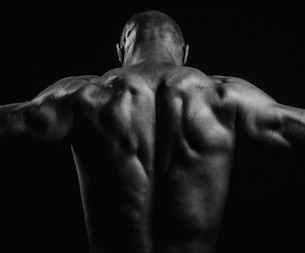Long ago in a land far far away, I used to train for hypertrophy with more of a bodybuilding style routine. Then one day I stumbled across the Madcow 5×5 routine. So me and myself said, “Yo bro! You so gotta do it dood!”
What does that have to do with anything? Get to the point already!
Well, over the years, I went from a hypertrophy model (training the muscles), to a combined strength/powerlifting and hypertrophy model, to an 99% exclusive powerlifting model (training the movements). Luckily my last training partner would hound me all the time about doing more hypertrophy work after we finished our primary / secondary lifts, so I would.
That was fine, but after he moved, I fell back into focusing on the big lifts and was just training the movements. (Squat / Bench / Deadlift).
Side note: It’s really funny how things work out in life right? Keep reading to see what I mean….
After talking recently with my previous training partner, I said to myself, self, you should really start working some hypertrophy back into your routine. The next day I found this article by Dave Tate. “Dave Tate’s Guide to Supplemental Movements with FULL Video“. (Not sure how I missed it for a year, but talk about perfect timing!)
I highly recommend reading the article and watching the video. I was planning on writing up a summary, but that wouldn’t do it justice.
I’ve always used slightly different terminology, but it’s basically the same. For example:
Main Lift = Primary Lift
Supplemental Lifts = Secondary Lifts
Accessory Exercises (That’s what I called it too).
Another place I fell short was letting there be a fuzziness between my “Secondary / Supplemental Lifts” and “Accessory Exercises”. Meaning, I didn’t train them with a very specific purpose in mind (like Dave talks about). Also, my “Main Lifts” are my main lifts… Squat / Bench / Deadlift. However, after reading this I may change it up.
I’m going to be tweaking my training, so I’ll be blogging about it and explaining why I’m doing what I’m doing, and the results.
Below are a few highlights from the article, along with the video
The Lifting TemplateCompetitive Lifts: Squat, Bench Press, Deadlift
Goal: To increase Competitive Max (CM)
Main Lifts: These can be known as the builders, core lifts, basic lifts, etc. These are the lifts the entire program is built around. For most programs it will be the squat, bench press, and deadlift, in others special exercises in the form of max effort movements may be used.
Finally, for those who aren’t competitive lifters, these lifts can be anything the lifter or coach feels has the highest dynamic correspondence (carry over) to the competitive lifts. To illustrate the last example, if I was working with a coach on how to better his/her own training philosophy, I’d first ask what 3-5 movements they feel carry over the most to the sport they’re working with. Whatever their answer is would replace the squat, bench, and deadlift as the competitive lifts.
Supplemental Lifts: These are movements we feel or know will make the main lifts either stronger or better from a technical standpoint. There may be 1-2 of these per session.
Accessories: These are the lifts that will support, balance, and help build the supplemental lifts.
Rehab / Prehab: While I can’t stand this term it’s what most will understand. These are those things we need to do to stay healthy, recovering well, and keeping our conditioning in line with the goals of the program.Dave Tate
Hmmm, I’m not sure why he hates that term. Maybe “Preventative Maintenance” is betterer.
1. Main Lifts – BuildersOne of my biggest takeaways in two sentences…
These are the exercises that build the squat, bench, or deadlift.2. Supplemental lifts
Supplemental lifts are intended to “supplement” the main lifts.3. Accessories
Lifters need to start asking themselves, “Where is my weakness/where am I getting stuck?” and start finding accessory movements to address it.
Dave Tate
The supplemental work is about the movement.
The accessory work is about the muscle.Dave Tate
Source: http://www.elitefts.com/education/supplemental-strength/

